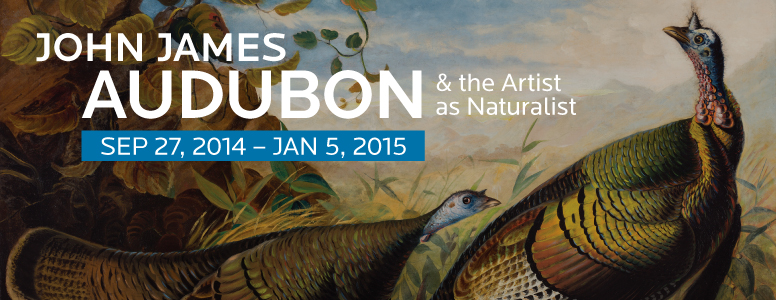Crystal Bridges Museum of American Art announces the John James Audubon and the Artist as Naturalist exhibition, September 27, 2014 – January 5, 2015, on view within the museum’s Colonial to Early 19th-century Art Gallery.
In his famous publication The Birds of America (1827–1838), American naturalist and artist John James Audubon depicts over 400 species of North American birds with his life-size prints. The exhibition will feature Crystal Bridges’ double elephant folio copy of The Birds of America, re-issued by Audubon’s son in 1861, and will highlight several artworks related to the renowned publication, including:
- Wild Turkey Cock, Hen and Young, which was painted during Audubon’s promotional tour in Edinburgh, Scotland in 1826 at a key moment in the artist’s career. This painting, part of the Crystal Bridges collection, is one of the few oil paintings by Audubon that are known to have survived. He used such paintings to raise funds and recruit subscribers for The Birds of America. Audubon created his bird studies using watercolor, pastel, pencil, and gouache. Wild Turkey Cock, Hen and Young is based on two watercolors that were among the first to be engraved for his famous collection of prints.
- Wild Turkey (ca. 1845), on loan from the Gilcrease Museum for this exhibition, is an almost identical oil copy of the first plate of his The Birds of America. The American wild turkey was Audubon’s favorite subject and is the largest species in his publication.
- Audubon’s oil painting Osprey and Weakfish, on loan from the National Gallery of Art, documents the artist’s skill in adding dramatic effects to his compositions, and will join the exhibition in November after a current loan concludes.
In addition, the exhibition features the New York Historical Society’s portrait of Audubon by his son John Woodhouse Audubon, works by Martin Johnson Heade, and Karl Bodmer, plus rare color plates by Mark Catesby and Alexander Wilson, artists who had in common a willingness to face challenges and take risks during their field studies and drawing expeditions to unexplored areas. Fidelia Bridges and Lucia Smith Carpenter Bliss, whose watercolors are included in the exhibition, were among the few successful 19th-century female artists who focused on smaller aspects of nature such as flower studies and birds and sought to express the truth and beauty of nature.
“This exhibition represents a spectacular early 19th-century approach to nature,” said Crystal Bridges Curator Manuela Well-Off-Man, who organized the exhibition. “These significant loans along with Heade, Bodmer, and other artists, link us to an era of discovery and scientific exploration. Their works reflect their different artistic and scientific methods and interests in nature. They all shared a commitment to create detailed studies of flora and fauna based on first-hand observation. We are thrilled to share these artworks that illustrate the artists’ eye for the beauty of the American wilderness with our visitors.”
“Audubon was a great explorer, naturalist, and artist who played a seminal role in American art history. We are delighted to share his quintessentially American artworks with our visitors,” said Crystal Bridges Executive Director Rod Bigelow. “The John James Audubon and the Artist as Naturalist exhibition complements our mission to tell the American story through art and nature.”
John James Audubon, Wild Turkey Cock, Hen and Young (detail), 1826, oil on linen, 47 1/2 × 59 1/2 in. Photography by Edward C. Robinson III.




